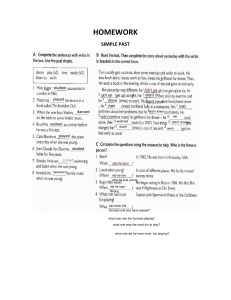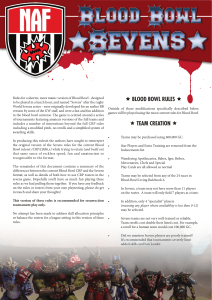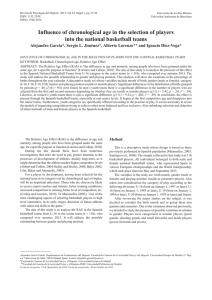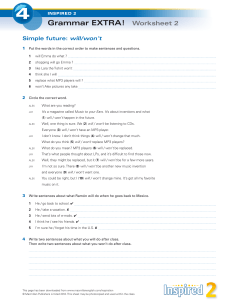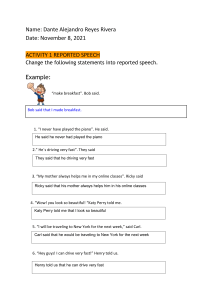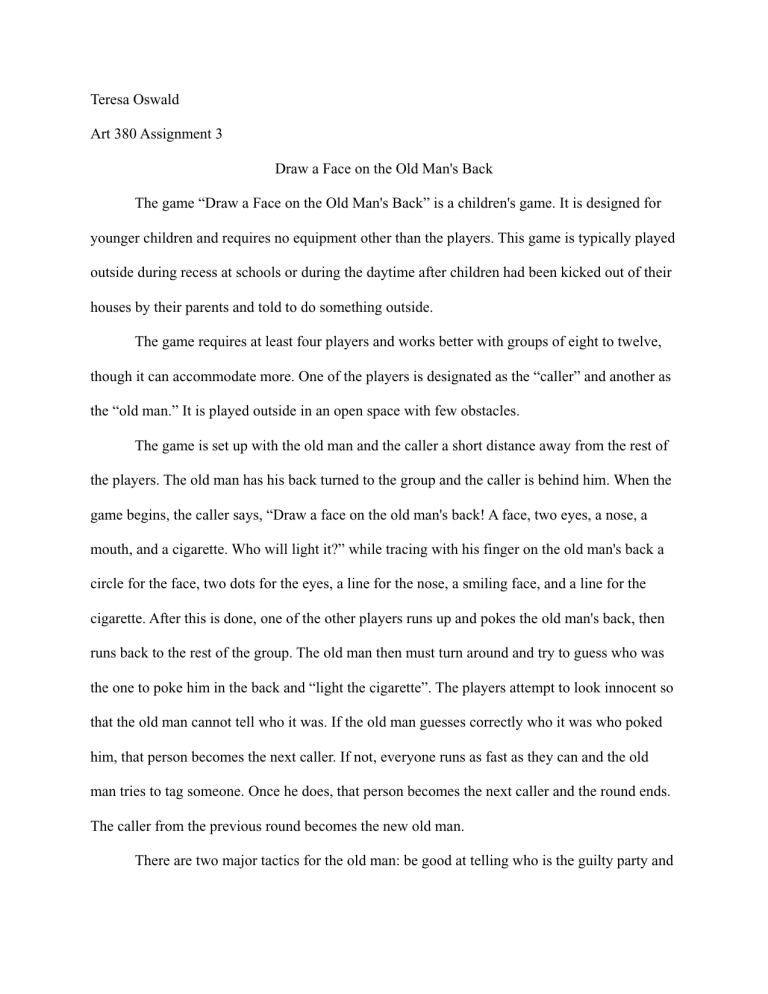
Teresa Oswald Art 380 Assignment 3 Draw a Face on the Old Man's Back The game “Draw a Face on the Old Man's Back” is a children's game. It is designed for younger children and requires no equipment other than the players. This game is typically played outside during recess at schools or during the daytime after children had been kicked out of their houses by their parents and told to do something outside. The game requires at least four players and works better with groups of eight to twelve, though it can accommodate more. One of the players is designated as the “caller” and another as the “old man.” It is played outside in an open space with few obstacles. The game is set up with the old man and the caller a short distance away from the rest of the players. The old man has his back turned to the group and the caller is behind him. When the game begins, the caller says, “Draw a face on the old man's back! A face, two eyes, a nose, a mouth, and a cigarette. Who will light it?” while tracing with his finger on the old man's back a circle for the face, two dots for the eyes, a line for the nose, a smiling face, and a line for the cigarette. After this is done, one of the other players runs up and pokes the old man's back, then runs back to the rest of the group. The old man then must turn around and try to guess who was the one to poke him in the back and “light the cigarette”. The players attempt to look innocent so that the old man cannot tell who it was. If the old man guesses correctly who it was who poked him, that person becomes the next caller. If not, everyone runs as fast as they can and the old man tries to tag someone. Once he does, that person becomes the next caller and the round ends. The caller from the previous round becomes the new old man. There are two major tactics for the old man: be good at telling who is the guilty party and being able to run really fast. The first largely depends on the people playing the game—if they are bad at acting, then the old man does not need to be good at discerning the one who poked him. Otherwise, the old man must be fast enough to tag someone. The tagging part has very little tactics involved as the game is usually played in an open field, but the old man should consider feinting and changing directions quickly to confuse the runners, or try to tire the runners out while conserving his own energy for a quick burst. As for the other players, they must be careful about who goes to tag the old man at the beginning of the round. If the same person does it too many times, then the old man will guess that person more often. Also, if the person who tags the old man is not fast enough, he might not be back with the rest of the group before the old man turns around, or he could be the only person in the group who is out of breath. This game has a lot of tense emotions at the beginning of the round when the old man is inspecting the group for signs of who poked him. The players wish to trick the old man, so the one who did the deed tries to pretend he didn't, while the rest of the players act as though they had. It is the old man's task to figure out who it was or else he has to chase people around, so he is under pressure to guess correctly or be subjected to the taunting of his fellow players. It is important for the caller to make sure the old man is far enough away from the rest of the players that they can have a decent head start if they have to run. Also, he must make sure the old man does not look too soon. This game is made for a younger generation and seems to be making fun of the elderly. The first part of the game is teaching kids how to harass the elderly and then lie about it, and then run for it afterwards. If they get caught by the old man, then they have to do an undesirable job—be the caller, who does almost nothing. This is meaningful to children because it relates to their lives. They like to rebel against authority, or at least pretend that they do, so they create games that emulate disobedient behavior without actually being disobedient. Children themselves probably do not realize the meaning of this game, but the meaning is clear to adults who see the game played. All in all, this seems like an interesting game. It promotes lying and dodging responsibility for actions, which is great fun for all ages. References My Aunt Suzy Oswald, who lives in Beaver, Pennsylvania.




